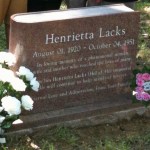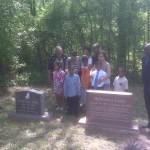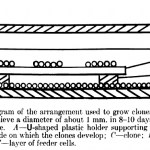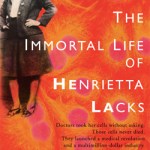I've been working for a while to develop a Frequently Asked Questions page to answers the most common reader questions about The Immortal Life of Henrietta Lacks. Well, it's now online, and it addresses questions ranging from why HeLa cells are immortal to how the Lacks family is benefiting from the book. It also includes answers to commonly asked publishing questions, like, How do I break into science writing? You can read it online here. If you have burning questions not answered there, leave them in the comments section below -- I'll add to the FAQ as questions arise and…
Henrietta Lacks
A biological basis for acupuncture, or more evidence for a placebo effect? Ed Yong ponders acupuncture, placebos, and context. This I like, and there's a nice meta dimension here as well: placebos being all about context.
Abel Pharmboy reports on Marking the magnificient memory of Henrietta Lacks. A nice account of what sounds like a lovely ceremony. Among other things, testifies to the potential power of the book.
Much ado about links and where they best belong. Starting points:Â Rough Type: Nicholas Carr's Blog: Experiments in delinkification, which gets examined by ReadWriteWeb…
Anyone interested in Henrietta Lacks and the grave marker finally placed on her long unmarked grave this weekend should click here immediately for a beautiful post by scientist David Kroll, who attended the unveiling ceremony. It's filled with beautiful photos of the day, and a tribute to all Henrietta's cells did for science. His photo below shows Henrietta's new headstone in much sharper detail than the one I posted yesterday with the text of the inscription. Visit his post for many more photos of the ceremony, the graveyard, and Henrietta's family.
In addition to my own photos herein, Tom McLaughlin posted a nice slide show of the day at his South Boston News & Record.
Despite two trees that snapped and fell in my driveway within six feet of my car in an impressive thunderstorm Friday evening, I drove on Saturday morning to Clover, Virginia, for the dedication of a gravestone that finally marks the final resting place of Henrietta Lacks, a concrete honor, if you will, to recognize the source of one of the most valuable medical tools of the 20th century and today.
For those who are not regular readers, Henrietta Lacks was a rural…
Today is a very exciting day: Henrietta Lacks (aka HeLa) has been lying in an unmarked grave since her death in 1951. Today, thanks to Dr. Roland Pattillo at Morehouse School of Medicine, who donated a headstone after reading The Immortal Life of Henrietta Lacks, her grave is finally marked. Below, a snapshot of some members of the Lacks family beside the new marker for Henrietta, and the marker for her daughter, Elsie, which was also unveiled today. Dr. Roland Pattillo is pictured at the far left:
Her stone, in case you can't tell from the picture, is shaped like a book.…
As some of you may have noticed, things have been a weeeeeeee bit quiet here at Culture Dish. This is what happens when a person embarks on a totally insane book tour. I've been on the road for two months straight since the publication of The Immortal Life of Henrietta Lacks, giving talks, signing books, meeting readers, and doing lots and lots and lots of interviews for TV and radio (talking to folks like Stephen Colbert, Jim Axelrod of CBS Sunday Morning, Terry Gross, and many others). This has been a wonderful experience, which I will be posting about soon (complete with…
This post is the third in a series on the origin and history of HeLa S3 cells. The first post details how I came about to ask this question when launching my independent research laboratory. The second post details the life and careers of the legendary physician-scientist pioneer, Dr. Florence Rena Sabin.
Today, we take up a discussion where we will finally learn the origin of HeLa S3 cells, complete with original literature citations.
A recap
We left our previous discussion with the final and still-productive years of Dr. Florence Rena Sabin. After graduating from Johns Hopkins Medical…
This post is the second in a series on the origin and history of HeLa S3 cells. The first post can be found here. In this post, we discuss the life and careers (yes, careers) of the remarkable physician-scientist, Florence Rena Sabin.
"Too bad you're not a boy, you would have made a good doctor."
Florence Rena Sabin was born in the mining town of Central City, Colorado, on November 9, 1871, two years after her sister and lifelong companion, Mary. Florence's father. George Sabin, had moved from Vermont to Colorado in the midst of the Colorado gold rush and a notable 1859 gold strike between…
When I first started my independent academic laboratory in 1992, it was in a brand new facility across the parking lot from a then 40-year-old building named in honor of the woman to the right. I took on a big teaching load from day one and while I had some cash left from the $50,000 start-up package, I didn't hire a technician immediately. So it fell upon me to do all the ordering of the basic supplies to get the operation rolling. No problem, right? I ordered much of my own stuff as a postdoc so it should be no problem to get everything I need to start the lab from scratch.
One of the…
Today's Baltimore Sun features a great OpEd by Ruth Faden, director of the bioethics institute at Johns Hopkins, exploring the ethical and moral issues raised by The Immortal Life of Henrietta Lacks, and its relevance to the current debate over health care reform. In it she says, among other things:
... Henrietta Lacks story touches the very heart of the
current debate over health care reform, and the need for universal
coverage and access to care. Her tale, like health care reform and the
ethics of biomedical science, is tied up in how the least of us live.
We need a national…
This is a special shout out to the doctors and scientists out there. Everything we do in our fields has repercussions, often unexpected ones. Because of this, we strive to practice ethically to help prevent or minimize negative repercussions.
This discussion comes up specifically as an epiphenomenon of the release of The Immortal Life of Henrietta Lacks (my full review can be found here.) How one reacts to this book would, I suppose, depend on your perspective. A neighbor of the Lacks's might react quite differently than a 22 year old doctoral student. And that's really the point.
This…
After ten long years, the serious countdown has begun for the publication of my book, The Immortal Life of Henrietta Lacks, which will be on sale nationwide exactly SEVEN DAYS from today. I've been posting about my impending book tour, and all the great coverage the book has been getting, on Twitter and Facebook, but thought I'd also post a bit of a press round up here, and an update, for those who (gasp) don't spend all of their time in those places.
If you don't know what my book is about: it tells the story of a poor black tobacco farmer whose cancer cells -- taken without her…
Look in any biomedical laboratory, and you will find HeLa cells. Over 50 million tonnes of these cells have been grown in churning vats of liquid all over the world. They have been one of the most important tools in modern medicine, pushing forward our understanding of cancer and other diseases, and underpinning the polio vaccine, IVF, cloning, and more. None of these advanced would have been feasible without HeLa. Most scientists have used or seen them but most have no idea about their origin. It's time to find out.
In early 1951, there was only one place in the world where HeLa cells could…
This past weekend's international science communication conference, ScienceOnline2010, also saw the first, final hardback copies of Rebecca Skloot's long-awaited book make it into the hands of the science and journalism consuming public. Moreover, an excerpt of The Immortal Life of Henrietta Lacks has just appeared in the new issue of Oprah Winfrey's O Magazine. And already, those online science communicators who left the conference with Skloot's book are registering their praise via this Twitter feed that was so active it was a trending topic at the science aggregator, SciencePond.
The story…
On Friday, I wrote a post about the 20th anniversary of my PhD dissertation defense and my reverence for Henrietta Lacks, the woman whose cervical cancer gave rise to the first immortalized human cell line and the primary system for my work. I also alluded to The Immortal Life of Henrietta Lacks, the upcoming book by Rebecca Skloot that is already garnering extensive pre-release praise.
I was, as readers have come to expect, quite a bit sentimental and reflective, with a call that we all do our part to somehow acknowledge those patients whose tissues make it possible for us scientists to do…
Big week here at Culture Dish! The Immortal Life of Henrietta Lacks and its author (yours truly) were on the cover of Publishers Weekly (please note: THRILLED!). Inside that issue was a profile of me with some of book's backstory, a short excerpt from the book (longer excerpt coming soon in O, the Oprah Magazine), also a story I wrote about the crazy book tour I'm organizing (posted about previously here). But that was just the beginning of this week's HeLa developments. More about that after the jump, but first, a warning: given the fact that my book is about to be released and…
Twenty years ago this morning, I had to defend a body of work that contained this paragraph on page 24:
HeLa cells are a human cervical carcinoma cell line having a doubling time of 24 hr and were obtained from Dr. Bert Flanegan, Dept. of Immunology and Microbiology, University of Florida. HeLa cells were maintained as subconfluent monolayer cultures in minimal essential media (alpha modification; GIBCO) with 10% fetal bovine serum (GIBCO) at 37° under a humidified atmosphere containing 5% CO2. Cells were maintained in logarithmic growth by subculturing every other day using 0.05% trypsin/0.…
Hella HeLa!
Skloot is PWned, as it were.
I learned late last night that author Rebecca Skloot was to be featured on the cover of this week's issue of Publishers Weekly. So, I clicked on the site this morning before the coffee was even done brewing and there is our wordsmithing hero.
I know that "The Making of a Bestseller 2010" is sure to make any author nervous but my reading of the manuscript tells me that the prediction is entirely consistent with the work.
Regular readers will know that we featured Ms Skloot here last week to brainstorm about her upcoming, self-supported book tour…
Calling all academics: If you'd like a free advanced copy of my book, The Immortal Life of Henrietta Lacks, get thee to Random House's academic blog and request a copy quick, while supplies last (which probably won't be long at the rate things are going). See below for more information on the book, and advanced praise. Added bonus: If you teach the book this spring, you can also get me to come speak at your school/in your classes as part of my book tour.
Here's Publishers Weekly on The Immortal Life of Henrietta Lacks:
Science journalist Skloot makes a remarkable debut with
this multilayered…
Some readers may be aware that Rebecca Skloot is about to release her much-anticipated book, The Immortal Life of Henrietta Lacks, a story that is about much more than the black Southern woman whose cervical cancer gave rise to the most famous human cancer cell line. (Crown, 2 Feb 2010, preorder here).
HeLa cells, as they are known, have played a role in the development of vaccines for polio and cervical cancer, the part of last year's Nobel Prize in Physiology or Medicine to Harald zur Hausen, and the PhD thesis 20 years ago of a certain natural products pharmacology blogger.
Having been…










